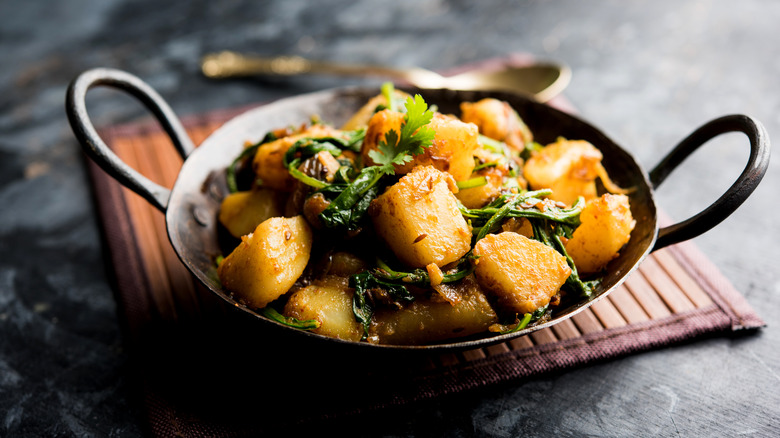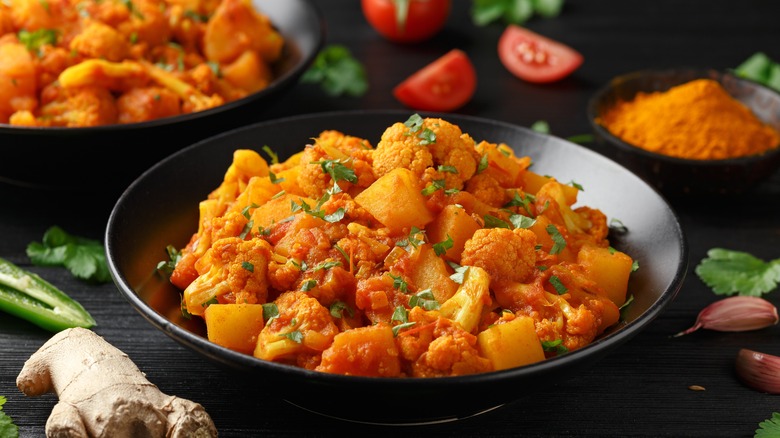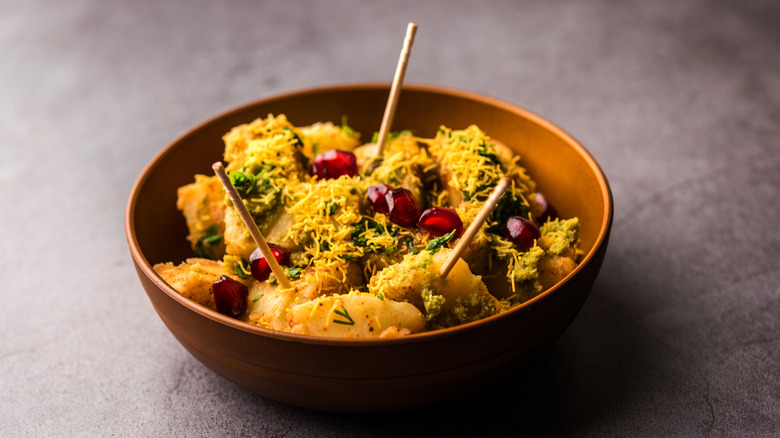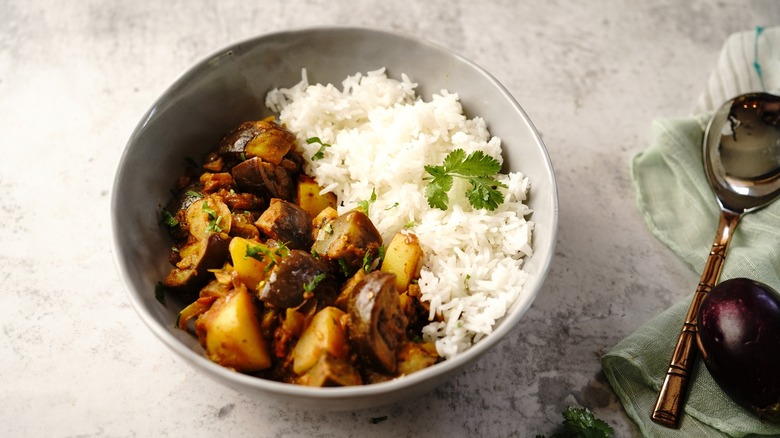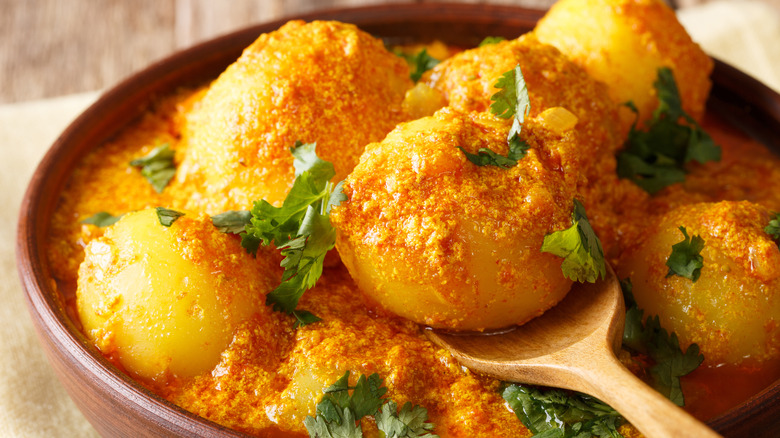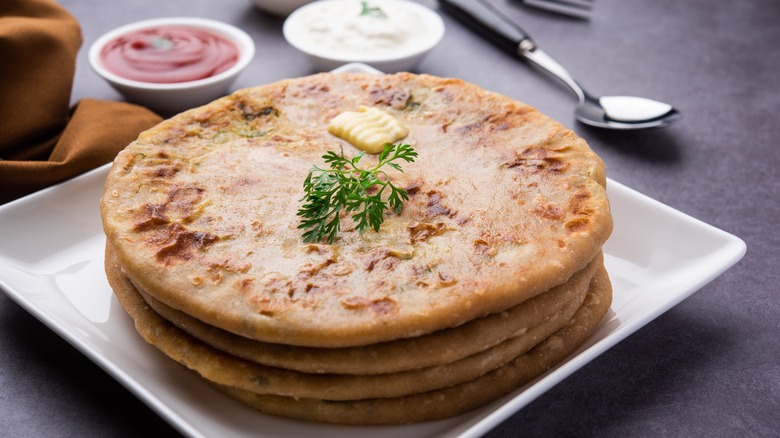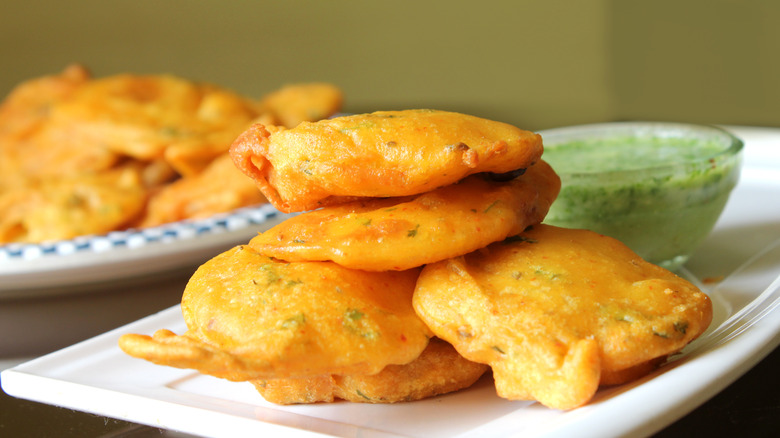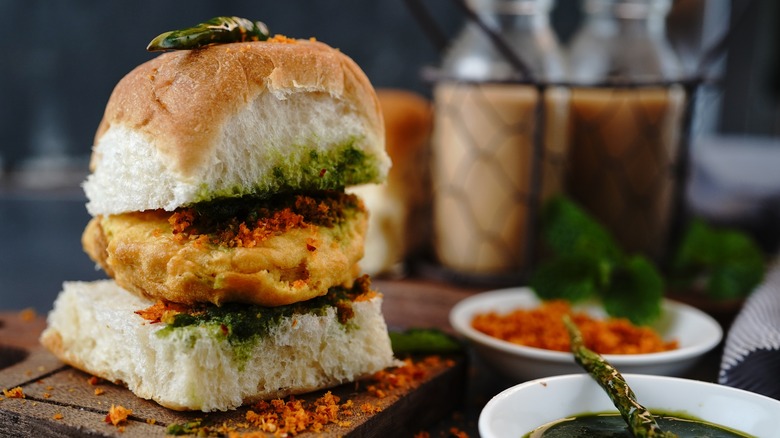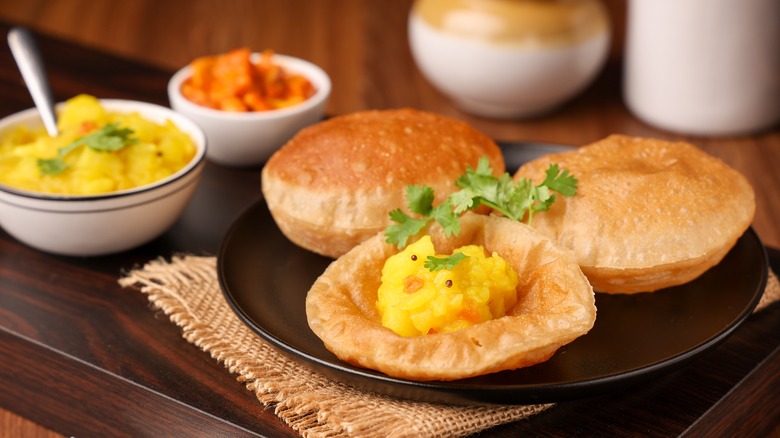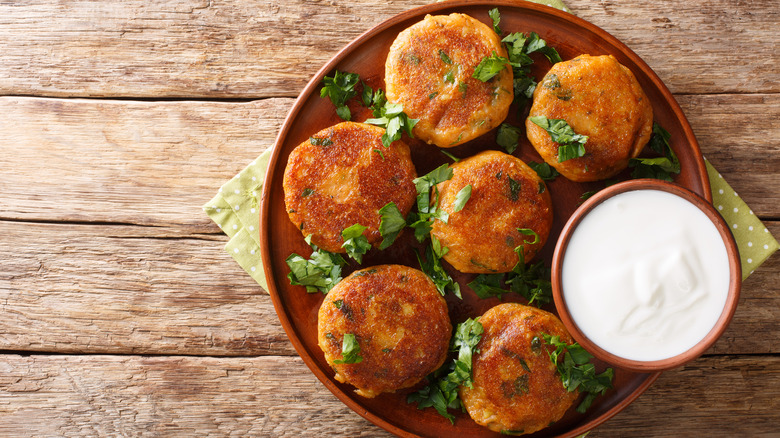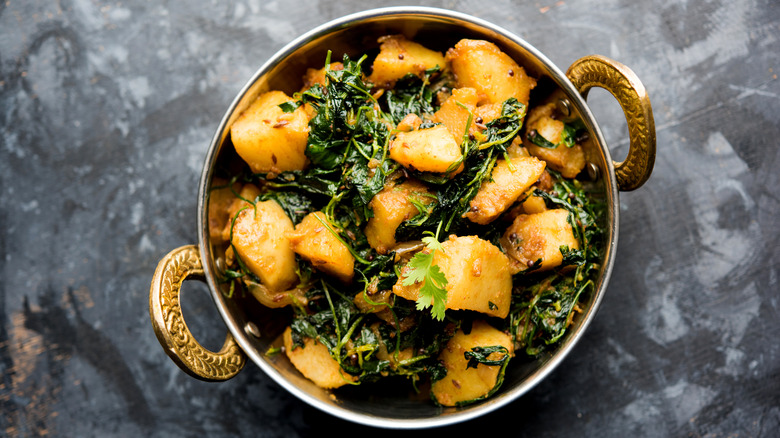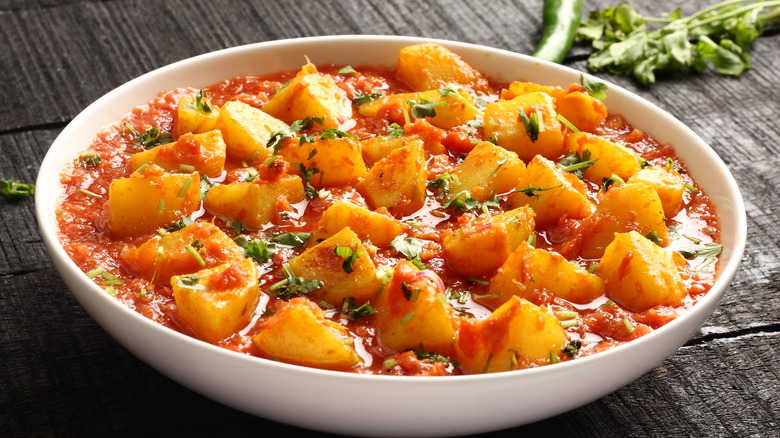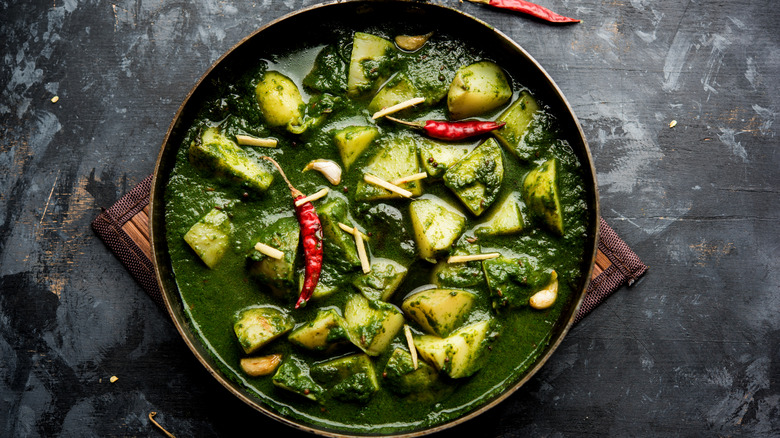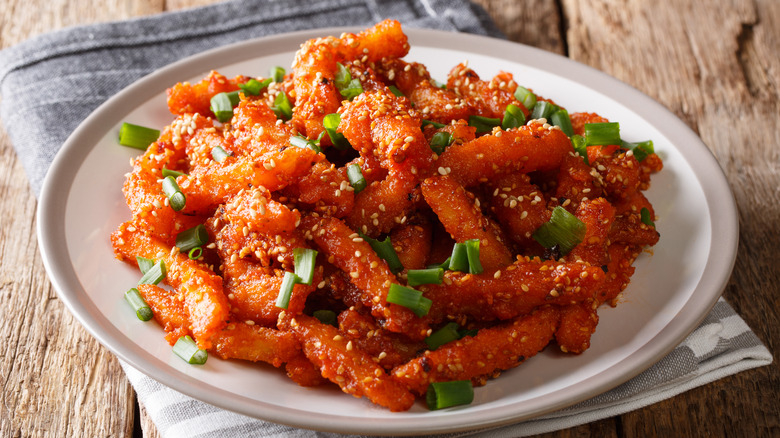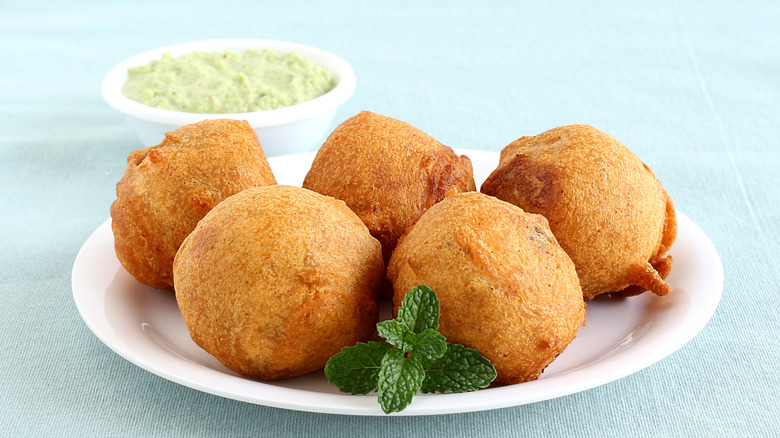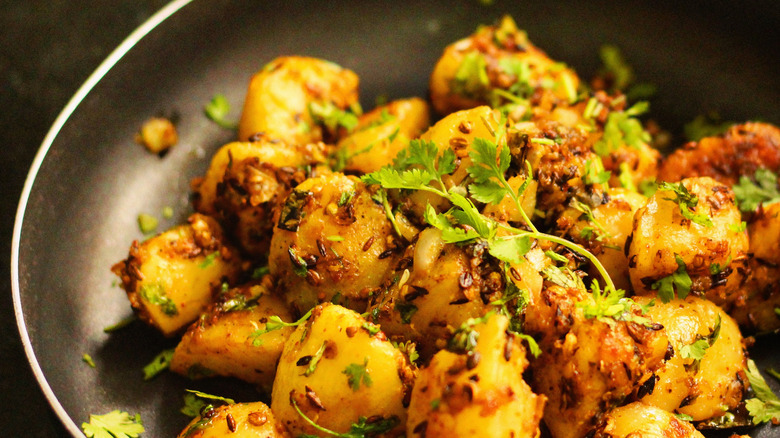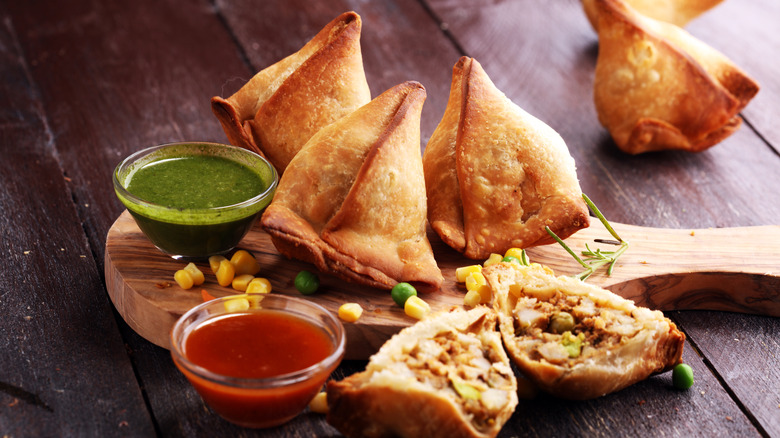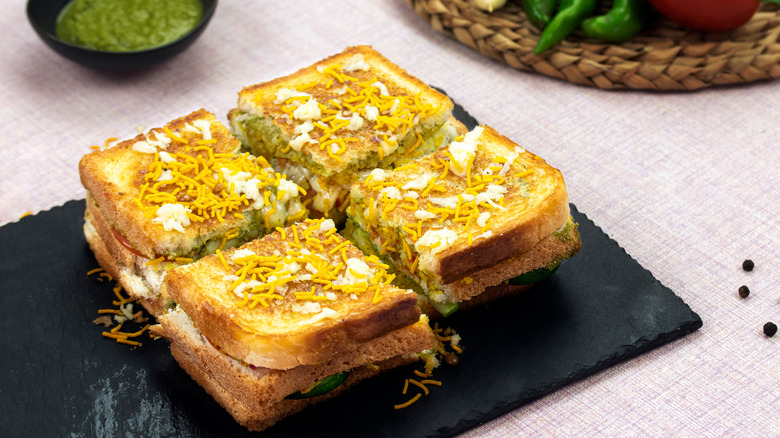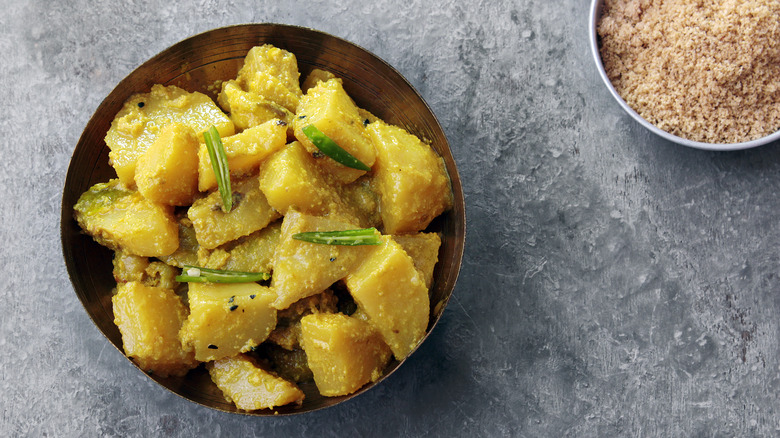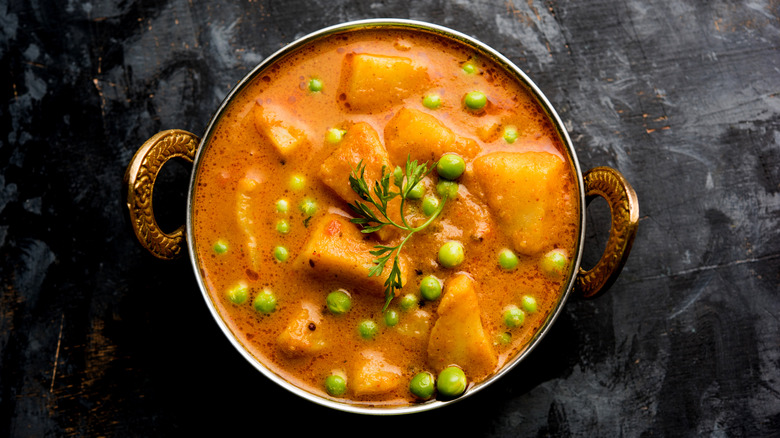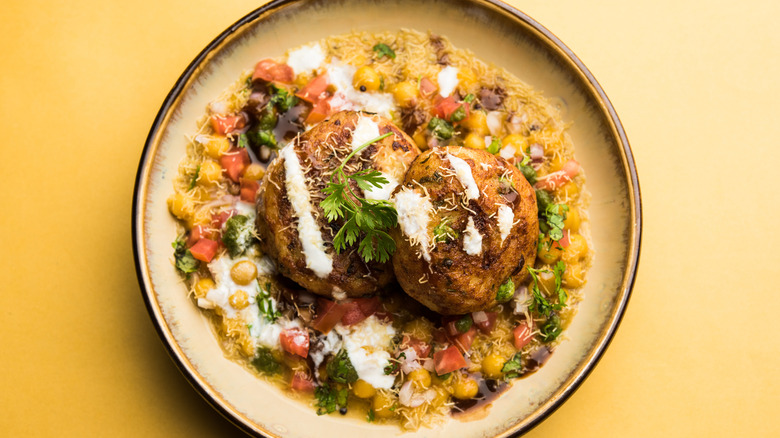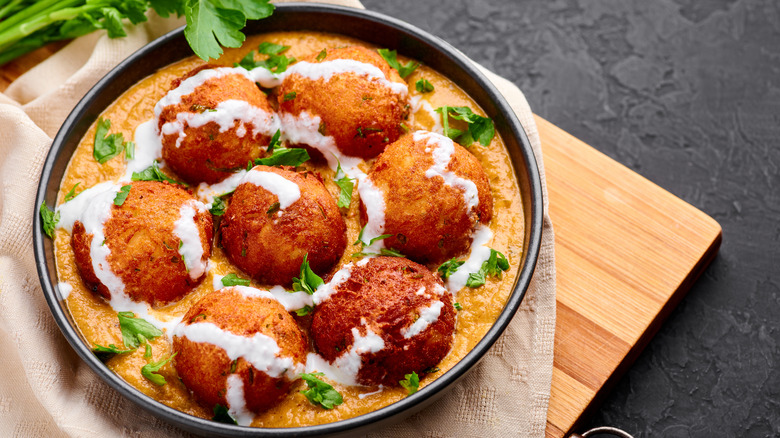22 Indian Potato Dishes You Should Try At Least Once
If we could pinpoint one moment in history that changed world cuisine forever, then Christopher Columbus' exploration of South America and the later discovery of potatoes in Colombia would be a strong contender. After European colonists brought the crop from South America to Europe, Africa, and Asia in the 1500s, the humble potato became a dietary staple of many generations across many countries.
One might forgive you for mistakenly believing that potatoes are a native Indian crop; after all, much like its European counterparts, the potato has become inseparable from traditional Indian fare. However, potatoes first reached India's shores on the boats of Portuguese and Dutch colonists and later spread across the region by the directive of the East India Company, which provided farmers with cheap seed potatoes to replace rice as the primary carbohydrate. While their mission ultimately failed — bread and rice retain a slight dominance — evidence of the past is still visible in India, whether through the Marathi word for potato, "batata," a loan from Portugese, or the sheer number of potato farmers.
In present-day India, everyone, from rural villagers to multi-millionaires, takes delight in potato-based recipes. They relish potatoes for breakfast in the form of aloo paratha, savor vada pav for lunch, and indulge in them for dinner, too. For every occasion and every course, potatoes come to the rescue — let's dive into which Indian potato dishes you should try.
Aloo Gobi
One of the most enduringly popular dishes on Indian restaurant menus is aloo gobi, a simple yet warming curry loaded with hearty potatoes, tender cauliflower, and robust spices. Aloo gobi is a delightful main dish for vegetarians and vegans, while omnivores can savor it as a lighter nibble. Typically, restaurants serve the dish dry so caramelized onions, tangy tomatoes, and fiery spices cling to each nook and cranny of the cauliflower florets.
In addition to its reputation across curry-loving countries outside the Indian subcontinent, aloo gobi is a traditional dish found throughout North India ("Aloo" means potato in Hindi; "gobi" means cauliflower.), where it's commonly eaten alongside lentil dal, chapatis, and steamed rice.
Aloo Chaat
From pani puri to dahi vada, India has a love affair with chaat. The beloved dish is named for its status as "chatpata," meaning foods that make you slap your lips from the sour, tangy flavors. Often sold from street carts or restaurants dedicated to the cuisine called chaat houses, it's the perfect snack — spicy, crunchy, sweet, and sour.
If there is one chaat you must try, it's aloo chaat, a potato dish perfect for serving at parties. The mouthwatering dish features crispy fried potatoes at the base, then topped with sweetened yogurt, fresh green chutney, sour tamarind sauce, juicy pomegranate arils, finely chopped onions, a smattering of vibrant cilantro, and brittle chickpea flour noodles. Ideally, serve it as a small-plate appetizer or set up a chaat station so everyone can help themselves.
Aloo Baingan
The wonderful thing about potatoes is that their mild flavor profile and versatile texture complement numerous other vegetables. One of those is succulent eggplant, known as baingan. In general, most people in India use small purple or green varieties of eggplant, sliced lengthways or diced into small cubes. However, if you don't have access to the traditional option, American eggplants (also known as globe eggplants) will work just as well when chopped small.
The epitome of a low-effort dish, all that's needed before you serve this dish with fluffy rice is to sauté soft potatoes and eggplant with punchy ginger garlic paste, robust spices, and concentrated tomato paste. Because of its melt-in-the-mouth texture, aloo baingan is ideally plated with crunchy fried poppadoms and cooling raita on the side.
Dum Aloo
Originating from the mountainous North-Western region of India known as Kashmir, dum aloo is a unique potato preparation. One of its distinctive features involves using whole baby potatoes, which undergo boiling and deep-frying in pungent mustard oil.
In contrast to typical Indian curries, the base takes a different route: instead of the usual tomato and onion sauce, dum aloo incorporates thick yogurt cooked with vibrant Kashmiri chili powder, peppery ginger, and sweet crushed fennel. The resulting curry exudes a highly aromatic and smoky aroma, courtesy of infused flavors from black cardamom, cinnamon sticks, and black cumin.
Aloo Paratha
While stuffed breads aren't widely available in the U.S., India is awash with bread recipes stuffed with anything from sweet nuts, lentils, radish, and of course, potatoes. Unlike Pennsylvanian Dutch potato rolls, aloo paratha does not consist of dough infused with potato. Instead, the moreish bread features spiced mashed potatoes seasoned with warming garam masala, sour dried mango powder, fiery chilis, and plenty of herby cilantro stuffed between two layers of thin, chewy, and slightly crisp paratha dough.
Traditionally, aloo parathas are loaded with a dollop of creamy butter or ghee and then dipped in sweetened yogurt or tangy Indian mango pickles. People across India eat aloo paratha for breakfast, but if that sounds too filling, it makes a great lunch and is also served beside creamy dal makhani.
Aloo Pakora
Is there anyone on this Earth who can resist the moreish delight of soft-on-the-inside, crispy-on-the-outside potato fries? We certainly can't. But if you thought the humble potato reached its apex with potato fries, you'd be mistaken. Meet Indian aloo pakora: thinly sliced potatoes dipped in a nutty chickpea flour batter seasoned with fresh cilantro, thyme-scented carom seeds, spicy chilis, and a dusting of salt. Even better, they're naturally vegan and gluten free.
All great snacks need an accompanying sauce, so serve aloo pakora alongside ketchup, green chutney, or hot sauce. People traditionally relish the crispy bites amidst the torrential rains of the monsoon months, but we think a plateful of aloo pakora is always a good choice.
Vada Pav
Often known as the "Indian burger," vada pav is one of the most recognized street foods from the bustling seafront metropolitan of Mumbai. Whether you call vada pav an Indian burger or a potato sandwich, it's an unmissable choice for Indian food enthusiasts. The treat, often wrapped in newspaper, is all about taste and texture. Soft and fluffy milk buns — pav — are spread with bright and herby green chutney, pungent and tongue-tingling dry garlic chili chutney, and thick tamarind sauce. However, the star ingredient is undoubtedly the vada, soft mashed potatoes flecked with peppery mustard seeds, citrus-scented curry leaves, and fresh herbs. The whole thing is dipped in a golden-colored chickpea flour batter, fried, and then sandwiched between two halves of the bun.
Puri Bhaji
Despite popular belief, not all Indian dishes have to be spicy. That's the case with puri bhaji, a Maharashtrian meal often part of festive feasts. The recipe has two components: puri, a crispy hollow bread, and bhaji, a dry potato curry.
If the golden-hued potatoes weren't a giveaway, puri bhaji is heavily spiced with turmeric powder, lending an earthy over note to the curry. Other spices — garlicky asafoetida, hot black mustard seeds, crunchy urad dal, and zesty curry curries — shine when tempered in peanut oil. The dish is uncomplicated, light on the palate, and works well as an appetizer course or main dish. Consider serving it alongside sweet kheer (Indian milk pudding) as a complete festive thali.
Aloo Tikki
Move aside, potato cakes. There's a new boss on the block. Indian aloo tikki is the perfect potluck or party dish: minimum effort, delicious, and a surprisingly effective way to use leftover mashed potatoes. Underneath the golden-brown crispy exterior lies a patty made from soft and fluffy mashed potatoes flecked with pungent black salt, fresh mint, tangy chaat masala, and plenty of cumin powder. In some recipes, either a delightfully crunchy nut-based mixture or fresh green vegetables fill the aloo tikki, providing extra textural interest.
Most prevalent as a North Indian evening snack, although the patties are scrumptious solo, you should pair aloo chutney with chutney. Specifically, vivid green chutney with mint, coriander, garlic, and green chilis. Or maybe go rogue and fuse with mayonnaise. Either is good.
Aloo Methi
You've likely heard of fenugreek, but have you ever cooked with it? The multifaceted herb has many uses, especially considering all of the parts of the plant are edible, including its seeds and leaves. While fenugreek seeds are easy enough to find, the fresh herb is a different case; you'll almost certainly have to travel to your local specialist shop. Fenugreek leaves taste like nutty, mildly bitter caramelized sugar or maple syrup. After being cooked, the greens wilt down and become mellower yet undeniably distinctive in flavor.
The most widely known dish to employ fresh fenugreek is aloo methi, a dry vegan stir fry. Although potatoes are the main ingredient, they're just a base for the fenugreek (methi), bulking out the dish and adding butteriness.
Aloo Curry
We couldn't write about Indian potato dishes without including the most obvious: aloo curry! Although there are many interpretations of potato curry, the classic dish — sans any additional vegetables, sides, or elements — is always guaranteed to impress.
Cubes of tender boiled potatoes swim in a thick sauce punctured by sweet and nutty cumin seeds in each bite. It's the ideal dish to be mopped up with butter-brushed naan and is highly adaptable to an array of eaters. Can't handle spicy food? Add less chili powder. Not in the mood to fuss around with ratios of spices? Use ready-made curry powder. For a quick midweek meal, you can even use ready-to-eat canned potatoes, which don't need cooking.
Aloo Palak
Of twenty superfoods you should consider adding to your diet, spinach is one of the most accessible — affordable, and available in every major grocery outlet. The leafy green pulls its nutritional weight, providing essential vitamins, minerals, and protein (via Healthline). One look at the eye-catching green color of aloo palak will tell you it's Popeye's favorite recipe.
As you may have guessed, aloo palak is made by blanching then puréeing fresh spinach with onions, garlic, ginger, and chilis into a deep, silky sauce. After being simmered with aromatic spices, boiled potatoes stirred through absorb all those lovely warming flavors. Why not top the dish with more fried garlic, then serve it with naan, paratha, or fragrant jeera rice. Aloo palak is bound to be a certified crowd-pleaser.
Chili Potato
In an increasingly multicultural global environment, few cuisines have remained immutable; many have adapted dishes or adopted entirely new ways of cooking, thanks to ever-growing immigrant populations. India is no different; In the latter half of the 18th century, the Hakka people from the Guangdong province of Southeast China first arrived in India, settling in Kolkata, West Bengal. Centuries later, the wok-fried techniques, umami-rich soy sauce-laced foods, and cornflour-slurry-thickened dishes are more popular across India than ever.
If you're a fan of crispy, sticky, and sweet dishes, you'll adore Indo-Chinese chili potatoes. The fry-shaped potatoes are coated in batter, then tossed in a spicy red sauce sweetened with honey, balanced with vinegar and soy, and sprinkled with sesame seeds. As a snack, it's dangerously moreish.
Potato Bonda
Deep-fried and potatoes. What two words suggest a more indulgent (and tasty) recipe? Aloo bonda is a South Indian snack from the Udupi hotels in Kanarkata. It bears similarity to its neighbor Maharashtra's batata vada, and while we'll never know which crispy potato ball came first, there are distinct differences.
A simple recipe at heart, aloo bonda begins by steaming potatoes, mashing them, and then tempering them with a typically South Indian mix of spices: hot and spicy black mustard seeds, earthy cumin, grated ginger, fried urad dal, aromatic curry leaves, and tangy lemon juice to freshen the flavor profile. Then rolled into balls and batted with the classic turmeric-spiced chickpea flour, aloo bonda is irresistible when accompanied by piping hot Indian tea, chai.
Jeera Aloo
Indian cuisine can often appear intimidating and overwhelming, given that the array of recipes typically involves countless ingredients and spices. If you find the complexity of the dishes daunting, give jeera aloo a shot. The simple, homely meal is made by boiling potatoes and then stir-frying them with warm and nutty cumin seeds, green chilis for heat, and a touch of turmeric to add that golden color. Despite its limited ingredients, the full-bodied flavor of cumin shines alongside ghee-soaked potatoes. From start to finish, it takes no more than 15 minutes — a rarity, especially for something so delicious. Because jeera aloo is a dry potato dish, it tastes best served alongside dal or wrapped in chapati and paratha.
Aloo Samosa
Few snacks have made quite an impactful global impression as samosa, a treat as celebrated outside India as it is within. These pastries have diverse stuffings, including minced lamb, paneer, or even sweetened condensed milk — but the most traditional of all is a gently-spiced potato and pea mixture seasoned with fenugreek seeds, dry mango powder, and plenty of fresh cilantro. Encasing the filling, a flaky, buttery, and crisp pastry is flecked with carom seeds. The resulting dish is so tempting it's impossible to eat only one.
If you want to make samosa at home, you can make the pastry yourself or buy it from an Indian grocery store. The snacks are typically deep-fried, but if you prefer less mess, opt for an air fryer samosa instead — it's equally appetizing.
Bombay Sandwich
When you picture Mumbai — previously known as Bombay — do you envision sandwiches? Probably not. The myth tells us that the proliferation of the sandwich in the U.K. was thanks to the 4th Earl of Sandwich (yes, really), and during the British colonization of India, it was introduced to the Asian country. At that point, India was already enraptured with bread and potatoes brought by the Portuguese. Sometime later, probably in the 1960s, the street food sensation — the Bombay sandwich — was born.
How is a Bombay sandwich distinct from any other? Green chutney spread on the bread, then layers of boiled potato, tomato, and cucumber sprinkled with chaat masala, assembled and grilled over fresh coals. Then it's topped with crispy sev and ready to eat.
Aloo Posto
India is a country with a vast cuisine spread across many regions. Some are perhaps not as widely known as they should be — that's certainly the case for Bengali fare. Aloo posto features a relatively obscure ingredient beloved by Bengali cooks: poppy seeds. While poppy seeds are famous for their morphine content and use in lemon-flavored desserts, Bengali cuisine utilizes the spice, called posto in the local language, to create a beautifully nutty, mildly sweet flavor to curries.
Traditionally, aloo posto is very simple, to let the poppy seeds shine. After soaking overnight, add a paste of blended white poppy seeds and green chilis to potatoes sautéed with onion seeds, turmeric, and salt. The thick, nutty sauce is a perfect complement to soft potatoes and steamed rice.
Aloo Matar
Unlike similar curries that typically pair potatoes with vegetables, aloo matar almost always comes with a velvety, rich, and creamy curry sauce. The Punjabi classic is straightforward enough to be cooked by beginner chefs yet sufficiently flavorsome to become a dinner-party showstopper. A simple base of browned onions, reduced tomatoes, ginger, garlic, and hearty spices imparts intense flavors. After the potatoes soak up those tempting aromas, we take it up a notch with smoky crushed dried fenugreek leaves and bursts of sweet, fresh peas.
Aloo matar is best coupled with hot puris, fluffy rice, or homely chapati. Like most Indian dishes, it keeps well in the refrigerator and often tastes better after the flavors have had time to infuse and settle the day after.
Bombay Potatoes
You'll have a hard time locating restaurants that serve Bombay potatoes in India, but if you find yourself in the U.K., the situation is quite different. Indian takeouts up and down the country — even in the remotest villages — will feature this best-selling side dish on its menu, with the simple potato becoming a beloved takeout tradition.
And it's no wonder they're so in demand. Fluffy, almost falling apart potatoes are coated in a thick, zingy seasoning sauce dominated by pops of roasted cumin seeds, black mustard seeds, and an abundance of fresh julienned ginger. Bombay potatoes are vegan, gluten-free, and perfect for any occasion. They may not be strictly traditional, but the British-Indian chefs knew what they were doing; you'll be hooked in no time.
Ragda Pattice
If you've ever eaten the British classic chips with mushy peas, this is the Indian equivalent. Actually, despite the similarities, that feels like a disservice. Ragda pattice, a street food that originates in Mumbai, India, is sold by vendors to satisfy hungry passersby. Like most chaat dishes, it has numerous components that all seem to balance effortlessly: buttery-soft potato patties, a thick and mildly spiced curry made from white marrowfat peas and laced with tamarind sauce, three ingredients green chutney, finely chopped fresh tomato, and diced red onion.
Traditionally, people enjoy ragda pattice without bread or rice, simply indulging in the spiced potato cakes and protein-packed curry. Squeeze over a liberal portion of lemon juice, sprinkle with crispy sev, and dig in.
Malai Kofta
The title of the most decadent, luxurious, and rich curry dish has to go to malai kofta. Although you may have heard "kofta" relating to meatballs around the world – specifically, the etymology is Persian – in this case, the dish is not a meatball but rather a crispy vegetarian potato ball made from a mixture of grated paneer cheese, soft potatoes, and fresh herbs.
In Hindi, malai translates to cream. So, it stands to reason that the sauce is silky, velvety, buttery, and above all else, creamy. Smooth puréed tomato and onion simmered with aromatic bay leaves, cinnamon, and cardamom, then a paste of nutty cashews, almonds, melon seeds, and poppy seeds makes the whole dish scrumptiously creamy. It's finished with spices, smoky dried fenugreek, and a drizzle of cream.
